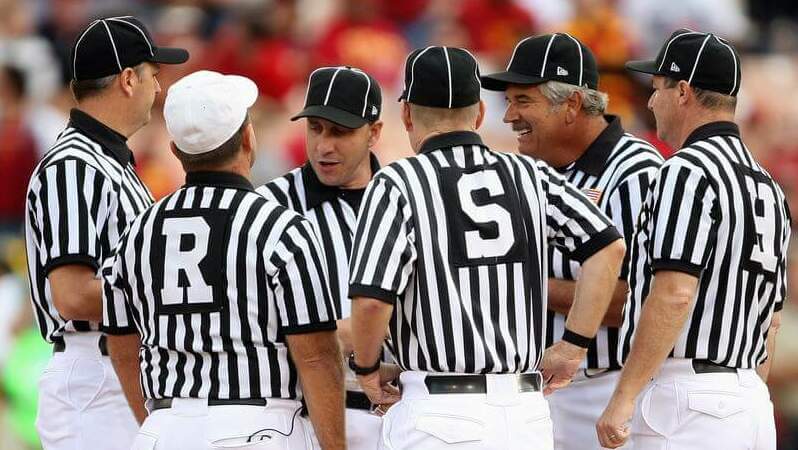
Good Saturday morning, Uni Watchers! I hope everyone has had a good week! While we’re in the week “off” from the final game of the NFL season, the NHL plays its All-Star game today (3:00 pm Eastern on ABC), and tomorrow, there’s the NFL “Pro Bowl” featuring flag football for the first time ever. To all our friends in the Northeast: it’s going to be brutally cold today, so stay safe!
As weekend readers are no doubt aware, a couple weekends ago I featured a great article, Honoring Letter Sweaters and Jackets by Timothy Brown, a Uni Watch exclusive. Tim has contributed a few pieces for Uni Watch.
I mentioned in that last article that I had subscribed to Tim’s Substack, and many of the articles he’s penned are right up Uni Watch’s alley. His Wednesday article (dutifully delivered to my inbox) linked to several of Tim’s prior pieces, one of which was entitled “How Football’s Zebras Got Their Stripes.” I thought it was such a fantastic piece — and right in UW’s sweet-spot — that I thought Uni Watchers would appreciate reading it as well. I asked Tim if I could reproduce the bit for Uni Watch, and he heartily agreed.
The football referee uniform is so distinct and iconic that we almost take it for granted. Sure, the stripes and designs have changed a bit over the years, but I had no idea of its beginnings. In fact, the current “zebra” striped referee uniform evolved over time, eventually becoming solidified as an iconic fixture. But how did it begin and how did it evolve? Let me turn this over to Tim right now…
by Timothy P. Brown
It is easy to see football today and think the game’s evolutionary path was inevitable, but there is nothing pre-ordained about today’s game. Football might have taken any number of alternative paths, and often did, though many of those twists and turns are forgotten today. Consider that American football was played on a field with a 55-yard line and no end zones until 1912. Only the tweaking of the rules of the recently allowed forward pass led to the adding of end zones and the elimination of the 55-yard line. Likewise, the first wearing of numbered jerseys came in 1905 when rivals Drake and Iowa State met. Drake wore numbers between 1 and 25; the Cyclones wore 26 to 50. As numbered jerseys became popular, players were not numbered by position. Even when the NCAA mandated that player numbers correspond to their position, there were multiple systems proposed, including alphanumeric combinations tried by a handful of schools.
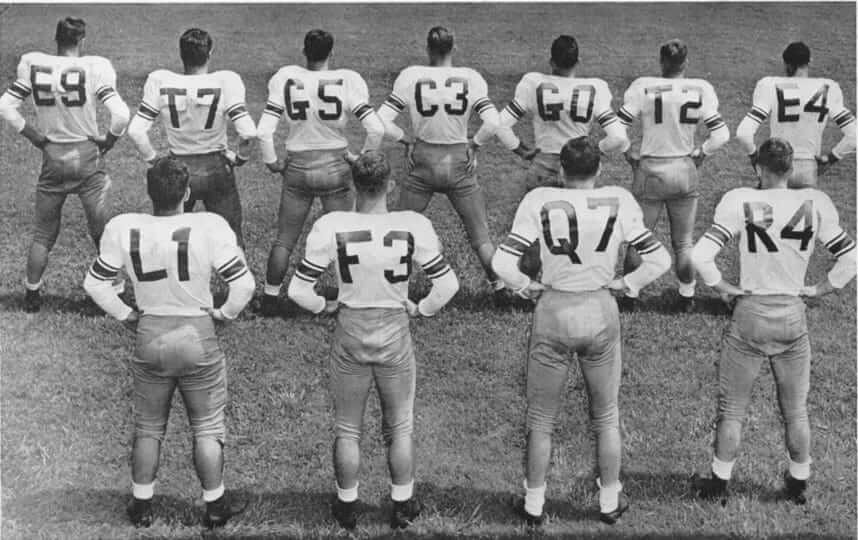
The point here is that many changes in the game arrived half-baked, were opposed by one faction or another, or benefited from a bit of fine tuning. And that brings us to the black-and-white striped shirts universally worn by football officials today. As I wrote in How Football Became Football, early football officials did not have uniforms; they wore everyday clothes. Many chose to wear older pants and jackets due to the need to keep pace with the players running around the field, as well as the muddy conditions of many football fields of the day. Besides everyday clothes, many officials wore their college letter sweaters during games. Letter sweaters marked the officials as authorities on the game and reinforced their neutrality since they generally did not work games involving their own college or schools with which they were associated. (Pre-WWII newspaper box scores typically listed the officials working the game and their alma maters.)
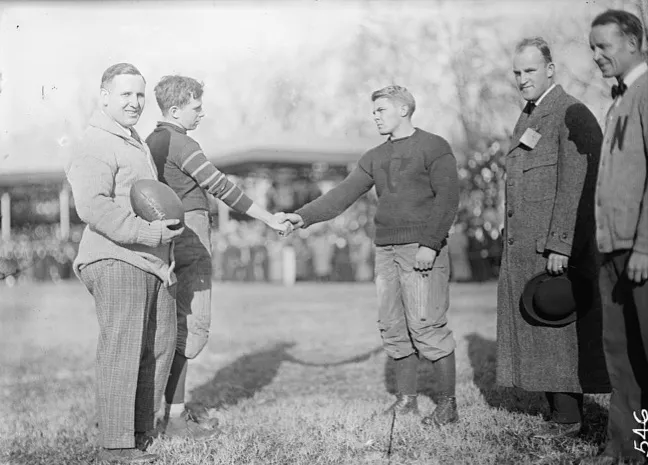
Beginning in the 1910s, basketball officials began wearing white shirts and bow ties during games. That practice leaked over to football, particularly among officials on the West Coast where warmer weather allowed officials to handle games in their shirt sleeves. Although officials wearing white shirts become widespread, it coincided with the emergence of teams wearing white jerseys. (As described in an earlier article, the white jerseys of the Twenties and Thirties were fashion choices unrelated to the 1950s trend of the visiting team wearing white jerseys.)
The wearing of white by football officials became a norm in the early 1920s, but Lloyd W. Olds, a professor and track coach at Eastern Michigan, grew frustrated when officiating football and basketball games because players whose teams wore white jerseys regularly tossed him the ball, mistaking his white shirt for a teammate’s jersey. To remedy the situation, Olds asked a local sporting goods store to create a shirt unlike any worn by football and basketball teams of the time. The result was the black-and-white, vertically-striped officials’ shirt that came to be known as the zebra shirt.
Officials in football and basketball picked up on Olds’ idea and the zebra shirt’s use spread organically. During the same period, high school officials at the state level and college officials at the conference and regional level organized to facilitate the training and scheduling of officials. As part of their efforts to standardize the quality of officiating, some state associations adopted the zebra shirt in the early 1930s and the Big Ten made it official for the 1937 season.

We all know that the black-and-white striped shirt became the standard officials’ shirt for football, basketball, wrestling, and hockey, so you might think the story ends there, but it does not. Nope. In fact, the zebra shirt had regional competitors that might have emerged as the standard nationwide, but the alternatives fell off one by one for reasons that are unclear.
Down in the Southern Conference, which in the early 1930s included the core of today’s Atlantic Coast and Southern Conferences, the Southern Football Officials Association (SFOA) took a different route. Rather than adopt the increasingly-popular zebra shirt, the SFOA opted for a white shirt with a black collar and stripe down the shirt’s front zipper. The SFOA logo over the left breast topped off the ensemble. The SFOA’s shirt came into use in 1932 – five years before the Big Ten adopted the zebra shirt – and remained the standard until 1941. Since the Southeastern Conference also used SFOA officials during the period, all major college games in the Deep South had officiating crews clad in these outfits.
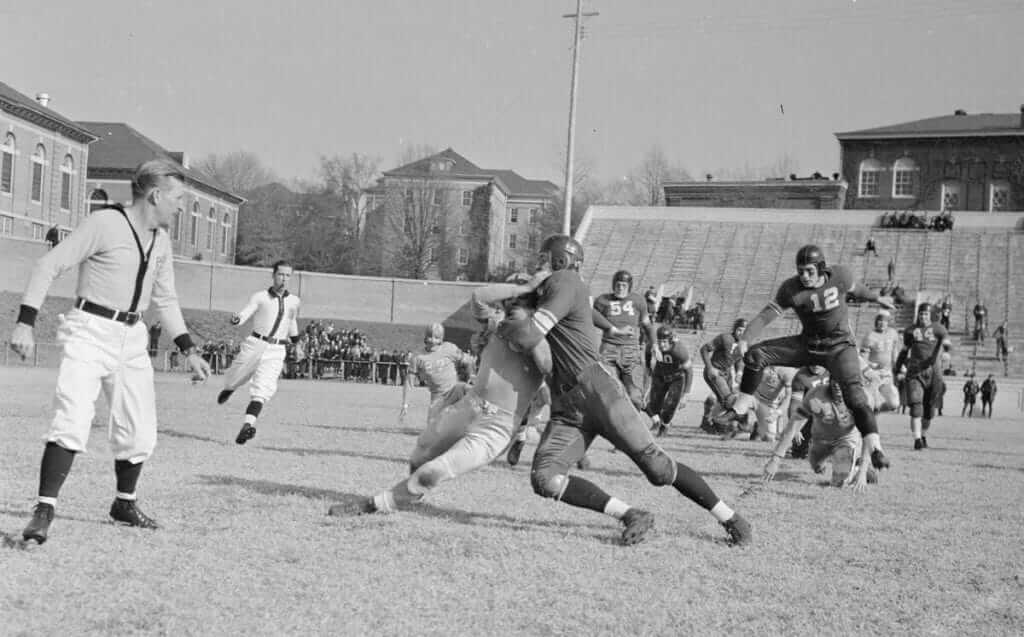
By 1941 the SFOA appears to have recognized their shirts did not stand out sufficiently, but opted not to switch to the standard zebra shirt. Instead, they adopted a zebra-like shirt with one-inch vertical stripes on the torso and one-inch horizontal stripes on the arms. The 1941 shirt was, in a word, an abomination, leading the SFOA to surrender and adopt the standard zebra shirt by the late 1940s.
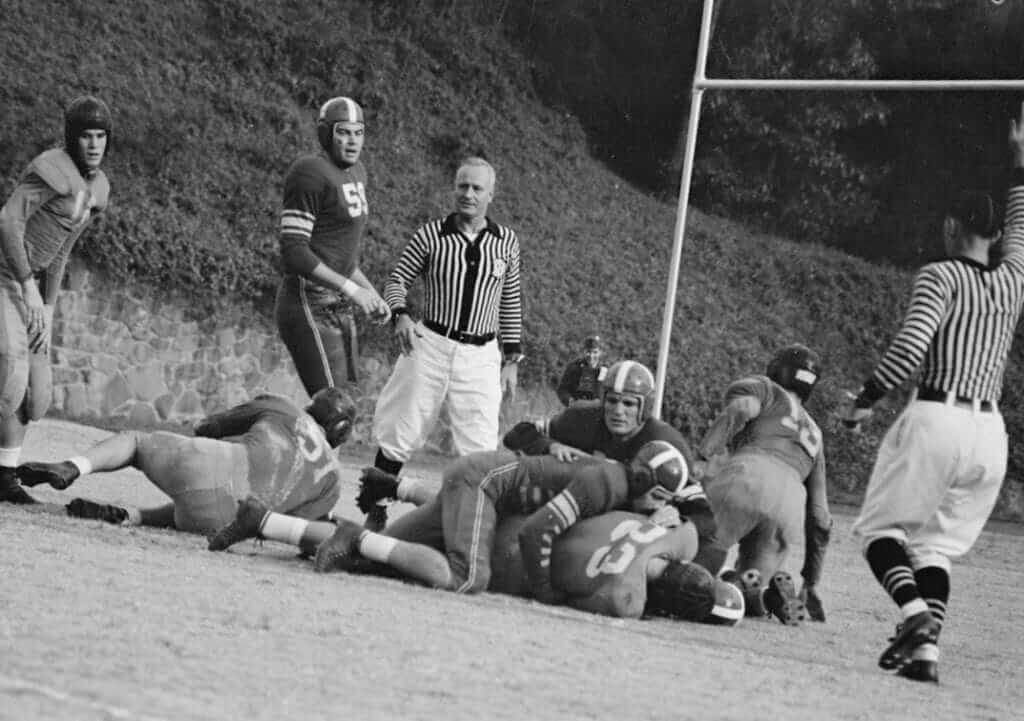
After switching to the standard zebra shirt, the SFOA made one lasting contribution to officials’ outfits in 1949 when they added patches with letters on the zebra shirts to designate each official’s role in the crew. The letter R designated the referee, U stood for umpire, L for head linesman, and J designated the field judge.
You might think alternatives to the zebra shirts ended there, but you would be wrong. Returning to the late 1930s, but heading further west, the officials handling Southwest Conference games also created an alternative to the zebra shirt. It seems that the Southwest Conference Officials Association (they also used the SFOA initialism, but we’ll refer to them as the Southwest Conference officials) wanted to grow its membership to enhance officiating standards and quality. At a time when many officials in the area had adopted zebra shirt, Abb Curtis, the head of the officials association, designed a shirt with V-shaped stripes on the front and back. By trademarking the design and allowing it to be worn only by members, the Southwest Football Officials Association distinguished its qualified members from the rabble wearing white or zebra-striped shirts. (The Lake Charles Football Officials’ Association in Louisiana used a V-striped shirt starting in the early 1930s, but is not known whether their shirt influenced the Southwest Conference design.)
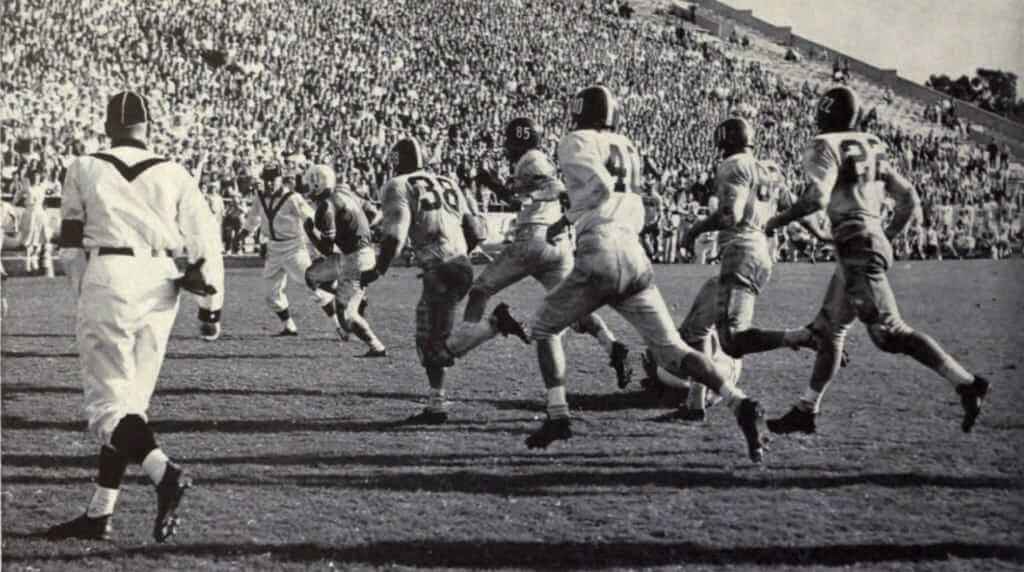
Unlike the SFOA folks that switched to the zebra shirt in the late 1940s, the Southwest Football Officials Association kept their V-striped shirts through the 1940s, and the 1950s, and most of the 1960s, before adopting the zebra shirt for the 1968 season. One can only speculate on the reason for the switch, but it followed soon after Abb Curtis’ retirement as head of the conference officials in 1967. Given that Curtis designed the V-striped shirt and headed the organization for many years, the V-striped shirt may have remained in use due to the members’ respect for Curtis.
A final note about the mix of shirt designs worn by football officials concerns the impact of multiple shirt designs on nonconference and bowl games. Prior to 1991 when the NCAA prohibited split officiating crews, games involving opponents from different conferences often had split crews manned by officials from the two teams’ conferences. That led to at least one officiating crew wearing mismatched uniforms, though most period images show split crews overwhelmingly wearing zebra shirts, perhaps to avoid drawing attention to each crew member’s conference affiliation.

The road to football officials consistently wearing the black-and-white striped shirt had multiple twists and turns, and this article did not even cover the various professional leagues experimenting with stripes in all colors of the spectrum. Still, it took sixty years of football before Lloyd Olds recognized the need and dreamed up the striped shirt and almost another half century before all college officials were consistently attired.
If you enjoyed this article, consider subscribing to my newsletter or check out my books.
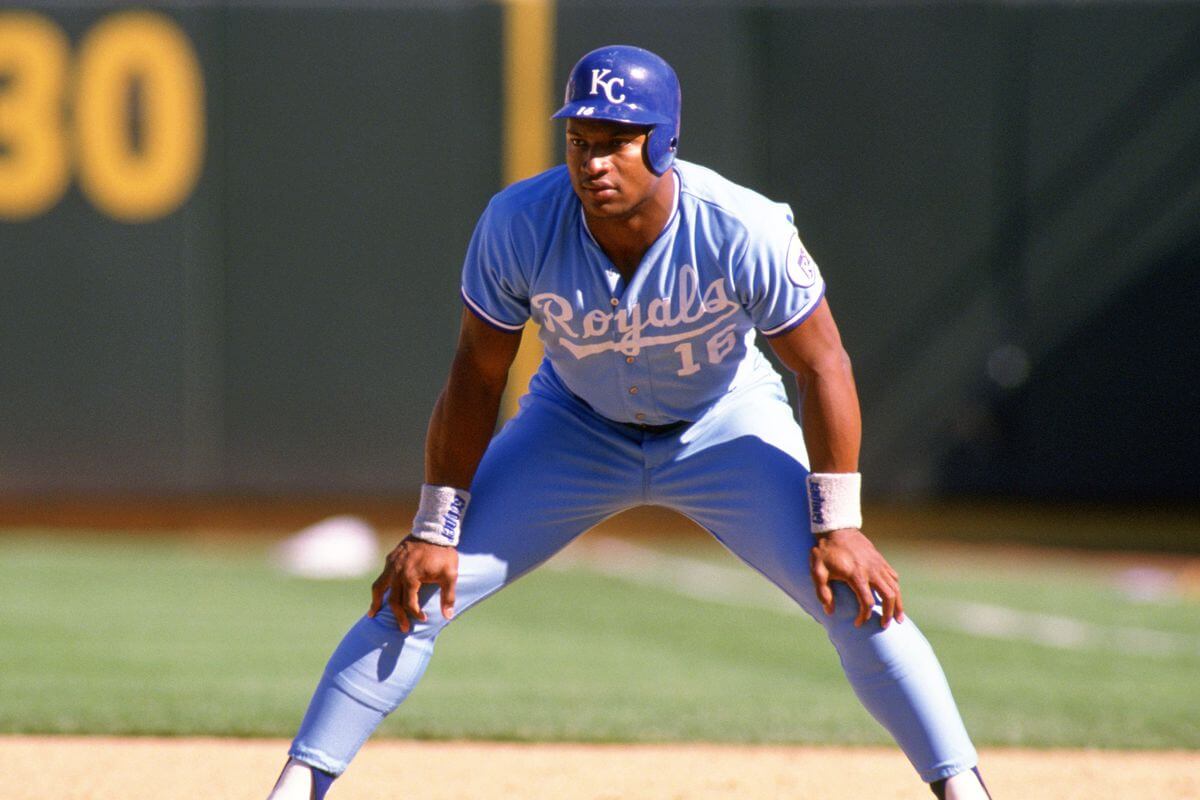
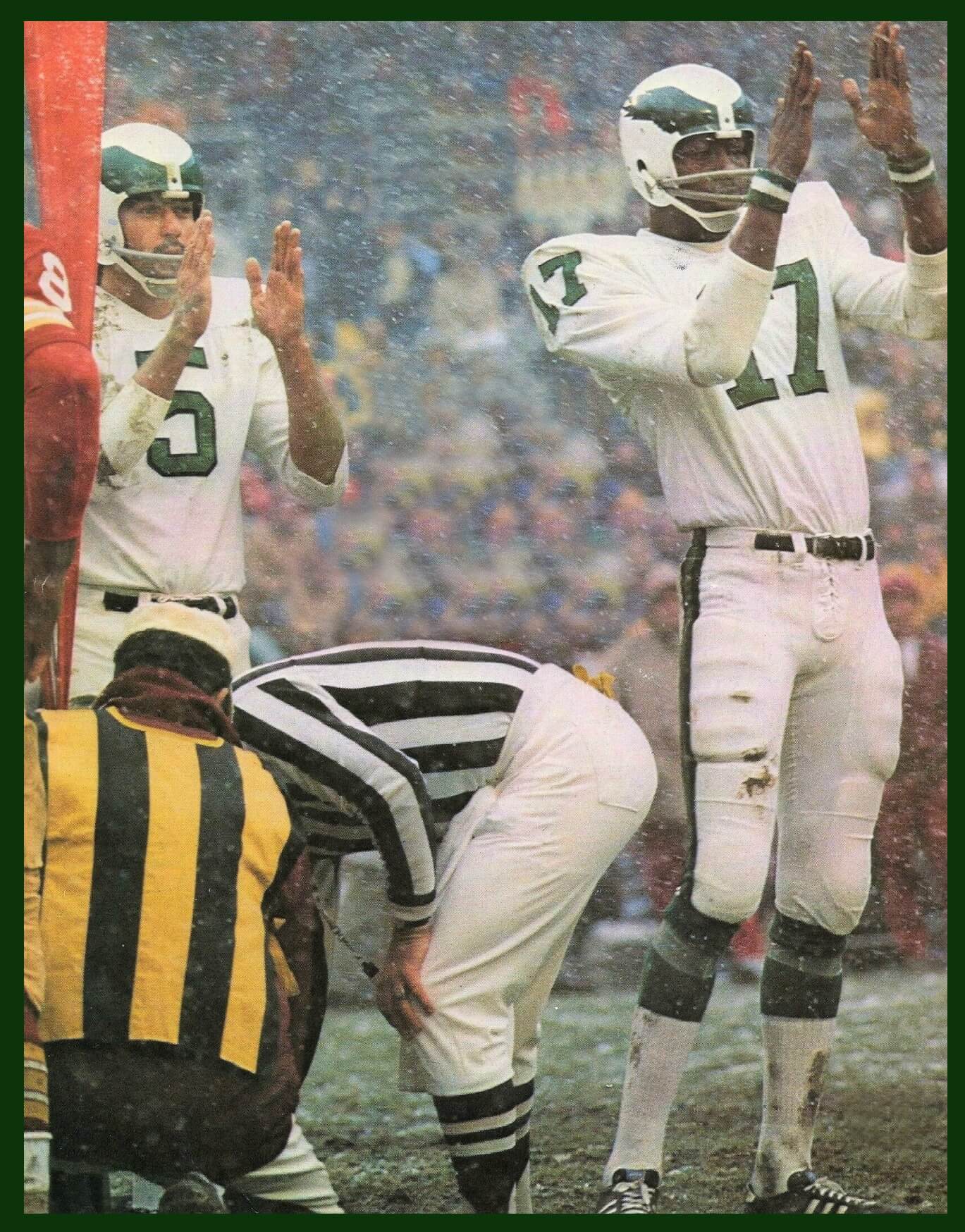
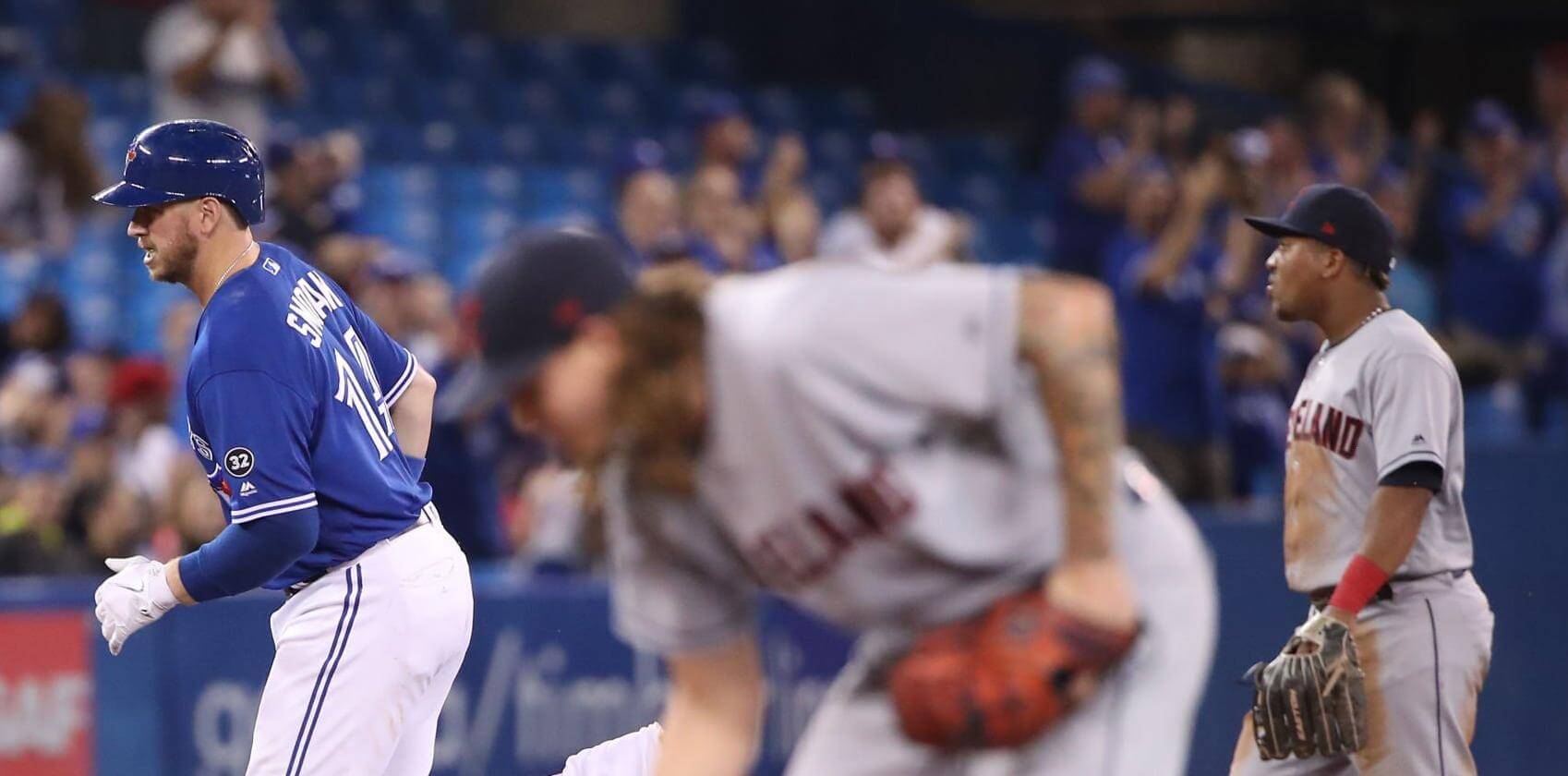


TV broadcasts used to regularly list the alma maters of officials, a practice carried over from newspaper accounts of games. Anyone know why and when they stopped?
Some of the match previews for English Premier League contests mention the home county of the referee. I guess it is meant to be a sign of impartiality?
“It’s not exactly a Venn diagram but…”
Yes, it is a Venn diagram.
A Venn diagram is a graphical depiction of sets. In this case, the sets include major league home jerseys. Some sets intersect (jerseys with team names and jerseys with numbers on the front) and some don’t (jerseys with locations and jerseys with emblems). One set can be a subset of another, like all members of the set of jerseys with birds being members of the larger set of jerseys with team names.
This has been today’s lecture on set theory.
I actually came here to say that, though definitely not as eloquently!
I tend to think the sets displayed here are poorly grouped. All teams have location or nickname depicted on their jersey; some have lettering across and some have initials.
APOSTROPHE CATASTROPHE ALERT: second paragraph, penultimate sentence.
Phil, another great find. And bonus thanks to Jerry. What other site can you read and learn about referee uniforms and Venn diagrams?
Glad to help.
The KC Royals need to grow a set and make the powder blues the regular road uniforms. Become a leader in the movement. One of the MLB teams need to do this someday. The Royals are the perfect team for it.
I’m not convinced very many fans, players, team officials, etc. realize it WAS a road uniform.
Agreed 100%. The Cards do wear their powder outfit on the road…but only for Saturday road games. I believe every other team that wears (full) powder blues only do it at home (or if on the road, rarely). The Royals would be the perfect candidate to wear those gorgeous powders for (almost) every road game!
I’ve always been a bit puzzled by the seeming reticence of the Royals to go full-powder. They’ve wholly-embraced powder blue over the last decade or so, between the jerseys and general team branding. Yet, when the wave of full powder blue uniforms came around 2020, they held off with the pants — and, even now, there’s the above-mentioned comment about it being for one game with a chance of another appearance. I almost wonder if there’s someone of influence in the front office who’s been completely opposed to powder pants all these years, and only acquiesced for one or two times this year (yeah, I know that sounds totally conspiratorial, but I’m trying to figure why the Royals seem so hesitant to embrace the look).
Just my guess, but I wouldn’t be surprised if they come out in their second powder blue jersey game of the season with white pants and have a bunch of fans online going “where are the pants?!?!” I’d imagine most are seeing the announcement and presuming it’s a full switch to all-powder (that was my initial takeaway) when they were those jerseys.
Awesome writing, Tim!
GTGFTU: September 9, 2018, Cleveland at Blue Jays
What caught my eye immediately was the “32” patch on the Blue Jays. They wore that in 2018 in honor of Roy Halladay, so it had to be that season. Furthermore, they played cleveland 7 times that season, so it had to be one of those 7 games. The picture features Justin Smoak, who didn’t play in 2 of those games, leaving five. Of those 5, 3 featured the uniform matchup featured in the image. Finally, Smoak appears to be rounding the bases, and he only got on base during one of those games, September 9, 2018
Great job Allan! From Chris Hickey when he sent that image to me:
Great detective work.
Way to go, Allen…really enjoyed reading your methodology!
I didn’t realize that the Jays wore the softball tops for more than that 1 game – mea culpa.
Do officials in any league, even high school, still wear white plus fours? Or have they all copied the NFL now?
Not so much a matter of copying the NFL, none of the suppliers even offer knickers anymore. One muddy game and I always wondered whose idea white knickers was for football.